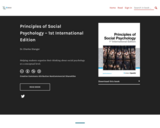
Helping students organize their thinking about social psychology at a conceptual level.
- Subject:
- Psychology
- Social Science
- Material Type:
- Textbook
- Provider:
- BCcampus
- Author:
- Charles Stangor
- Date Added:
- 11/01/2021

Helping students organize their thinking about social psychology at a conceptual level.

Originating in the work of Sigmund Freud, the psychodynamic perspective emphasizes unconscious psychological processes (for example, wishes and fears of which we’re not fully aware), and contends that childhood experiences are crucial in shaping adult personality. The psychodynamic perspective has evolved considerably since Freud’s time, and now includes innovative new approaches such as object relations theory and neuropsychoanalysis. Some psychodynamic concepts have held up well to empirical scrutiny while others have not, and aspects of the theory remain controversial, but the psychodynamic perspective continues to influence many different areas of contemporary psychology.
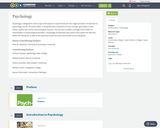
Psychology is designed to meet scope and sequence requirements for the single-semester introduction to psychology course. The book offers a comprehensive treatment of core concepts, grounded in both classic studies and current and emerging research. The text also includes coverage of the DSM-5 in examinations of psychological disorders. Psychology incorporates discussions that reflect the diversity within the discipline, as well as the diversity of cultures and communities across the globe

Psychology is designed to meet scope and sequence requirements for the single-semester introduction to psychology course. The book offers a comprehensive treatment of core concepts, grounded in both classic studies and current and emerging research. The text also includes coverage of the DSM-5 in examinations of psychological disorders. Psychology incorporates discussions that reflect the diversity within the discipline, as well as the diversity of cultures and communities across the globe.
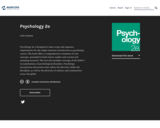
Psychology 2e is designed to meet scope and sequence requirements for the single-semester introduction to psychology course. The book offers a comprehensive treatment of core concepts, grounded in both classic studies and current and emerging research. The text also includes coverage of the DSM-5 in examinations of psychological disorders. Psychology incorporates discussions that reflect the diversity within the discipline, as well as the diversity of cultures and communities across the globe.

The first chapter provides an overview of the textbook and reviews the history of psychology and its methodology. Psychology is described as a science studying how hereditary (nature) and experiential (nurture) variables interact to influence the thoughts, feelings, and behavior of individuals. The remainder of the text will be organized in sections entitled “Mostly Nature” (Biological Psychology; Sensation & Perception; Motivation & Emotion), “Mostly Nurture” (Direct Learning; Indirect Learning (i.e., observational learning and language); Cognition), and “Nature/Nurture” (Human Development; Personality; Social Psychology; Maladaptive Behavior; Professional Psychology and Human Potential).

This textbook provides standard introduction to psychology course content with a specific emphasis on biological aspects of psychology. This includes more content related to neuroscience methods, the brain and the nervous system. This book can be modified: feel free to add or remove modules to better suit your specific needs.Please note that the publisher requires you to login to access and download the textbooks.
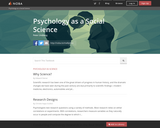
Provides standard introduction to psychology course content with a specific emphasis on social aspects of psychology. This includes expanded content related to social cognition, aggression, attraction and similar topics.

Sexuality is one of the fundamental drives behind everyone’s feelings, thoughts, and behaviors. It defines the means of biological reproduction, describes psychological and sociological representations of self, and orients a person’s attraction to others. Further, it shapes the brain and body to be pleasure-seeking. Yet, as important as sexuality is to being human, it is often viewed as a taboo topic for personal or scientific inquiry.

Psychopharmacology is the study of how drugs affect behavior. If a drug changes your perception, or the way you feel or think, the drug exerts effects on your brain and nervous system. We call drugs that change the way you think or feel psychoactive or psychotropic drugs, and almost everyone has used a psychoactive drug at some point (yes, caffeine counts). Understanding some of the basics about psychopharmacology can help us better understand a wide range of things that interest psychologists and others. For example, the pharmacological treatment of certain neurodegenerative diseases such as Parkinson’s disease tells us something about the disease itself. The pharmacological treatments used to treat psychiatric conditions such as schizophrenia or depression have undergone amazing development since the 1950s, and the drugs used to treat these disorders tell us something about what is happening in the brain of individuals with these conditions. Finally, understanding something about the actions of drugs of abuse and their routes of administration can help us understand why some psychoactive drugs are so addictive. In this module, we will provide an overview of some of these topics as well as discuss some current controversial areas in the field of psychopharmacology.

Psychologists test research questions using a variety of methods. Most research relies on either correlations or experiments. With correlations, researchers measure variables as they naturally occur in people and compute the degree to which two variables go together.

What do infants know about the world in which they live – and how do they grow and change with age? These are the kinds of questions answered by developmental scientists. This module describes different research techniques that are used to study psychological phenomena in infants and children, research designs that are used to examine age-related changes in development, and unique challenges and special issues associated with conducting research with infants and children. Child development is a fascinating field of study, and many interesting questions remain to be examined by future generations of developmental scientists – maybe you will be among them!
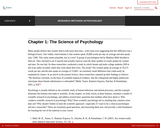
The present adaptation constitutes the second Canadian edition and was co-authored by Rajiv S. Jhangiani (Kwantlen Polytechnic University) and I-Chant A. Chiang (Quest University Canada) and is licensed under a Creative Commons Attribution-NonCommercial-ShareAlike 4.0 International License. Revisions include the following:
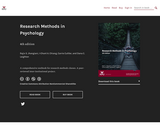
This fourth edition (published in 2019) was co-authored by Rajiv S. Jhangiani (Kwantlen Polytechnic University), Carrie Cuttler (Washington State University), and Dana C. Leighton (Texas A&M University—Texarkana) and is licensed under a Creative Commons Attribution-NonCommercial-ShareAlike 4.0 International License. Revisions throughout the current edition include changing the chapter and section numbering system to better accommodate adaptions that remove or reorder chapters; continued reversion from the Canadian edition; general grammatical edits; replacement of “he/she” to “they” and “his/her” to “their”; removal or update of dead links; embedded videos that were not embedded; moved key takeaways and exercises from the end of each chapter section to the end of each chapter; a new cover design. In addition, the following revisions were made to specific chapters:

This textbook is an adaptation of the Research Methods in Psychology that is available on this site in US and Canadian editions. This New Zealand edition is an adaptation to the New Zealand context. The main changes are in Chapters 1 and 3 and the spelling, grammar, and terminology are changed throughout. This textbook is adopted at the University of Waikato in our 200-level research methods in psychology class.
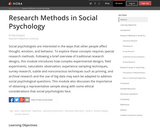
Social psychologists are interested in the ways that other people affect thought, emotion, and behavior. To explore these concepts requires special research methods. Following a brief overview of traditional research designs, this module introduces how complex experimental designs, field experiments, naturalistic observation, experience sampling techniques, survey research, subtle and nonconscious techniques such as priming, and archival research and the use of big data may each be adapted to address social psychological questions. This module also discusses the importance of obtaining a representative sample along with some ethical considerations that social psychologists face.

The term “self-efficacy” refers to your beliefs about your ability to effectively perform the tasks needed to attain a valued goal. Self-efficacy does not refer to your abilities but to how strongly you believe you can use your abilities to work toward goals. Self-efficacy is not a unitary construct or trait; rather, people have self-efficacy beliefs in different domains, such as academic self-efficacy, problem-solving self-efficacy, and self-regulatory self-efficacy. Stronger self-efficacy beliefs are associated with positive outcomes, such as better grades, greater athletic performance, happier romantic relationships, and a healthier lifestyle.

10 social psychology questions in an ineractive quiz.

No matter what you’re doing--solving homework, playing a video game, simply picking out a shirt--all of your actions and decisions relate to your consciousness. But as frequently as we use it, have you ever stopped to ask yourself: What really is consciousness? In this module, we discuss the different levels of consciousness and how they can affect your behavior in a variety of situations. As well, we explore the role of consciousness in other, “altered” states like hypnosis and sleep.

In the past century, a number of psychotherapeutic orientations have gained popularity for treating mental illnesses. This module outlines some of the best-known therapeutic approaches and explains the history, techniques, advantages, and disadvantages associated with each. The most effective modern approach is cognitive behavioral therapy (CBT). We also discuss psychoanalytic therapy, person-centered therapy, and mindfulness-based approaches. Drug therapy and emerging new treatment strategies will also be briefly explored.